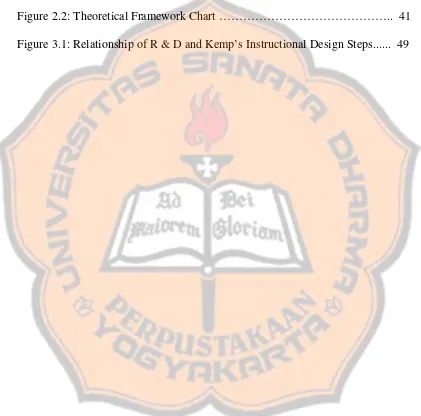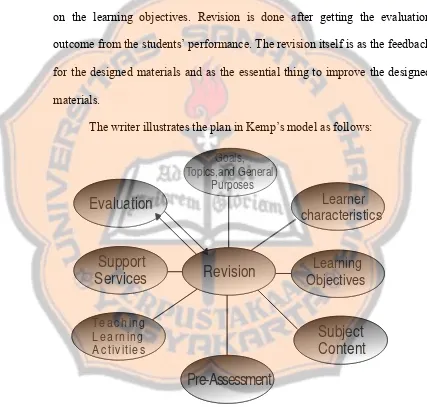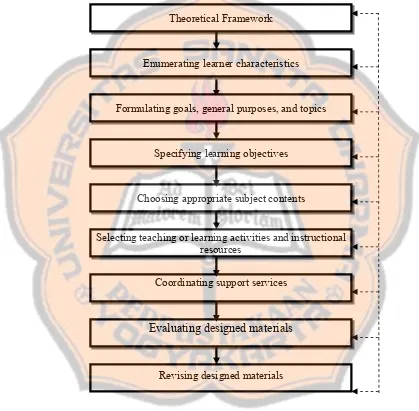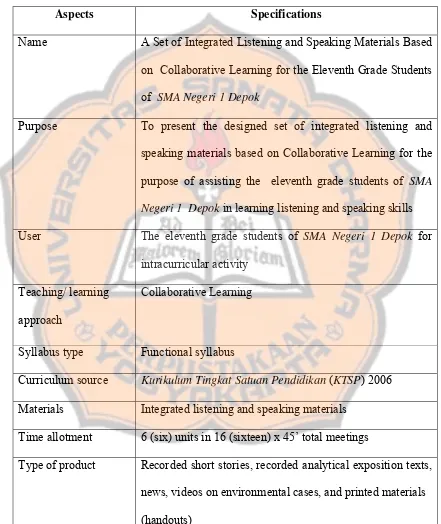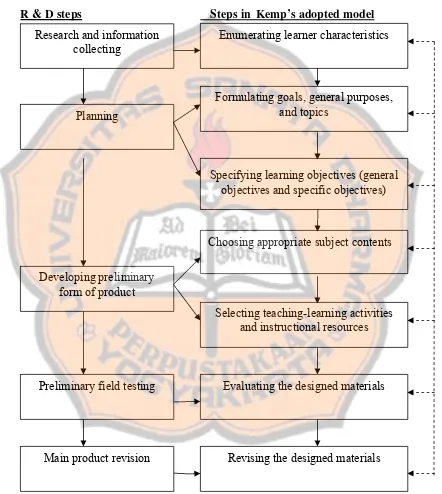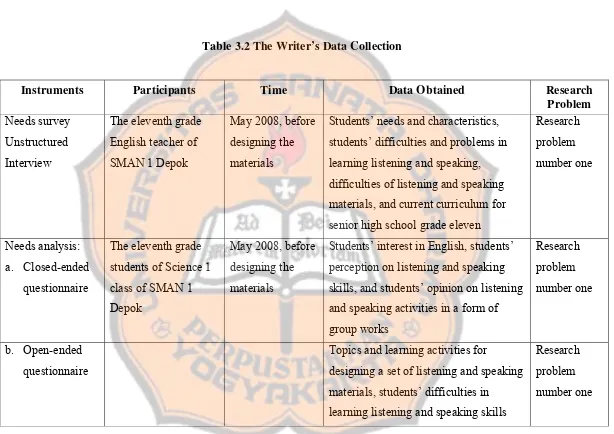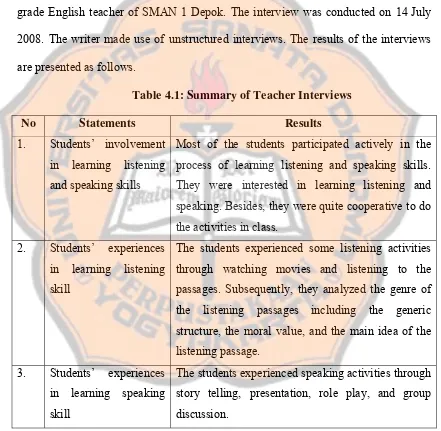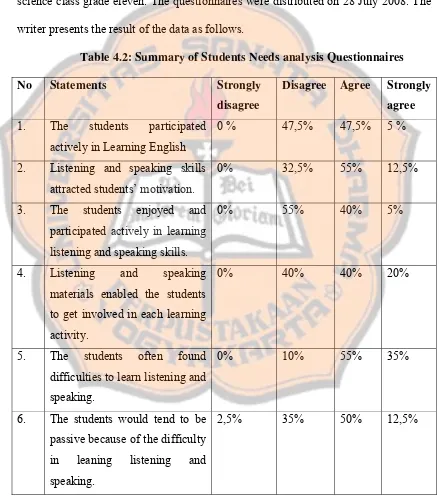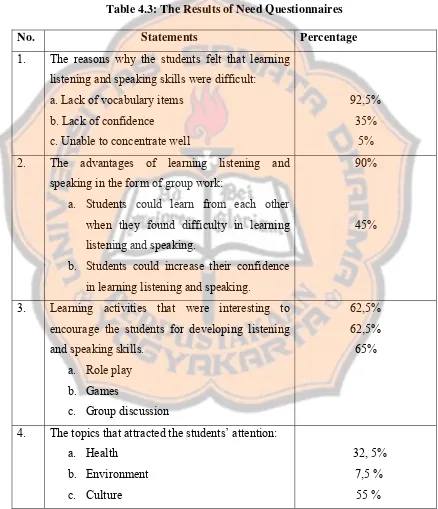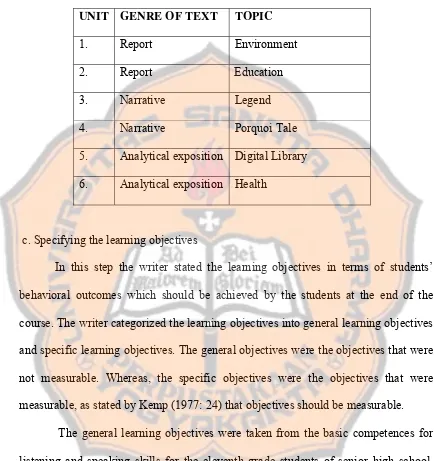xvi ABSTRACT
Pratiwi, Agustina Budi Pratiwi. 2009. Designing a Set of Integrated Listening and Speaking Materials Based on Collaborative Learning for the Eleventh Grade Students of SMA Negeri 1 Depok. Yogyakarta: English Language Education Study Program, Sanata Dharma University.
Listening and speaking are important language skills for learners to develop. Unfortunately, the teaching of listening and speaking is still frequently problematic, particularly in SMA Negeri 1 Depok. The limitation of instructional materials and learning media is believed to be one of the obstacles of the implementation of effective listening and speaking teaching-learning activities. Considering that, this study is then aimed at developing a set of integrated listening and speaking materials based on Collaborative Learning for the eleventh grade students of SMA Negeri 1 Depok.
There were two questions formulated in the problem formulation, namely, (1) how is a set of integrated listening and speaking materials based on Collaborative Learning for the eleventh grade students of SMA Negeri 1 Depok designed? and (2) what does the designed set of the materials look like?.
To answer the first question, the writer employed the adaptation of Kemp’s instructional design model as the realization of Educational Research and Development (R & D) method. There were nine instructional design steps employed in this study, namely, (1) enumerating learners’ characteristics, (2) formulating goals and general purposes, (3) formulating topics, (4) specifying learning objectives, (5) listing subject contents, (6) selecting teaching or learning activities and instructional resources, (7) coordinating support services (budget, personnel, and equipment), (8) evaluating the designed set of the materials, and (9) revising the designed set of the materials.
In this study, the data obtained through needs survey served as the basis to develop the materials. Whereas, the data obtained by conducting evaluation and expert validation served as the basis for revisions. The data gathered from conducting evaluation and expert validation showed that the designed set of the materials was well-developed, although some revisions were necessary. Based on the comments and suggestions from the evaluators, the writer improved the materials related to subject contents and learning activities.
xvii ABSTRAK
Pratiwi, Agustina Budi. 2009. Designing a Set of Integrated Listening and Speaking Materials Based on Collaborative Learning for the Eleventh Grade Students of SMA Negeri 1 Depok. Yogyakarta: Program Studi Pendidikan Bahasa Inggris, Universitas Sanata Dharma.
Mendengarkan dan berbicara merupakan keterampilan berbahasa yang
penting untuk dikembangkan. Namun demikian, pengajaran mendengarkan dan
berbicara masih sering menjumpai banyak kendala, khususnya seperti yang terjadi di SMA Negeri 1 Depok. Sangat terbatasnya materi pembelajaran listening dan speaking
serta kurangnya media pembelajaran diyakini sebagai salah satu penghambat penerapan kegiatan pembelajaran mendengarkan dan berbicara yang efektif bagi para siswa di sekolah. Penelitian ini bertujuan untuk mengembangkan seperangkat materi
mendengarkan dan berbicara berdasarkan Collaborative Learning untuk kelas XI SMA Negeri 1 Depok.
Dalam penelitian ini, terdapat dua pertanyaan dalam perumusan masalah yaitu (1) bagaimanakah seperangkat materi mendengarkan dan berbicara berdasarkan
Collaborative Learning untuk siswa kelas XI SMA Negeri 1 Depok dirancang? dan (2) bagaimanakah penyajian materi mendengarkan dan berbicara yang telah disusun tersebut?.
Untuk menjawab pertanyaan yang pertama dalam perumusan masalah, penulis mengadaptasi model perancangan instruksional yang dikembangkan oleh Kemp sebagai realisasi metode Educational Research and Development (R & D). Terdapat sembilan langkah perancangan instruksional dalam penelitian ini. Langkah-langkah tersebut adalah (1) pengidentifikasian karakteristik siswa, (2) perumusan tujuan dan tujuan umum, (3) perumusan topik, (4) perumusan tujuan khusus, (5) perincian isi materi, (6) pemilihan dan pengembangan kegiatan pembelajaran (pengembangan materi pembelajaran), (7)pengkoordinasian peralatan pendukung (anggaran dan perlengkapan), (8) pengevaluasian materi, dan (9) perevisian/perbaikan materi.
Dalam penelitian ini, data yang diperoleh melalui survei analisa kebutuhan siswa digunakan sebagai dasar pengembangan Sedangkan, data yang diperoleh dari evaluasi kemudian digunakan sebagai acuan untuk revisi. Data yang diperoleh dari melaksanakan evaluasi dan validasi ahli menunjukkan bahwa seperangkat materi telah dikembangkan dengan baik, meskipun masih diperlukan beberapa revisi. Berdasarkan saran yang diperoleh dari penilai, penulis memperbaiki materi yang berkaitan dengan isi materi dan aktivitas pembelajaran.
Untuk menjawab pertanyaan yang kedua, penulis menyajikan hasil akhir dari materi yang dirancang. Materi tersebut terdiri dari 6 unit yaitu Environment (unit 1),
i
DESIGNING A SET OF INTEGRATED LISTENING AND SPEAKING MATERIALS BASED ON COLLABORATIVE LEARNING
FOR THE ELEVENTH GRADE STUDENTS OF SMA NEGERI 1 DEPOK
A Thesis
Presented as Partial Fulfillment of the Requirements to Obtain the Sarjana Pendidikan Degree
in English Language Education
By
Agustina Budi Pratiwi
Student Number: 041214027
ENGLISH LANGUAGE EDUCATION STUDY PROGRAM DEPARTMENT OF LANGUAGE AND ARTS EDUCATION FACULTY OF TEACHERS TRAINING AND EDUCATION
SANATA DHARMA UNIVERSITY YOGYAKARTA
ii
vi
When things go wrong, as they sometimes will,
When the road you’re trudging seems all up hill,
When the funds are low and the debts are high,
And you want to smile, but you have to sigh,
When care is pressing you down a bit,
Rest, if you must, but don’t you quit
vii
ACKNOWLEDGEMENTS
First of all, I would like to express my gratitude to my Lord, Jesus Christ, for His blessings and guidance so that I was able to finish my thesis.
Next, I am very grateful to Ag. Hardi Prasetyo, S.Pd., M.A., the head of English Language Education Study Program for giving me permission to conduct the study. I would like to address my sincere gratitude to my sponsor, Dr. Retno Muljani, M.Pd. for her willingness to share her knowledge, give correction, advice, and support throughout the development of my thesis. In addition, I would like to thank Mrs. Ndari and Mrs. Marni for willingly spending their time evaluating my designed materials. I would like to thank Mbak Danik, Mbak Tari, and Mas Andi for always being pleased to provide any information needed.
I am deeply grateful to all lecturers of the English Language Education Study Program of Sanata Dharma University for their guidance and knowledge they have shared for the past four years. I would also like to address my sincere gratitude to the English teachers of SMAN 1 Depok, Mr. Subiyadi and Mrs. Sri Suryanti, for their help, advice, guidance, and suggestions to my designed materials.
viii
I wish to thank all my classmates: Elisabeth Aditya, Theresia Vina I., Agnes Nora E.W., Yosepha Rini, Retno Sukesi, and Agnes Woro Dwi Priharini for willingly sharing the joy and spirit during my study in this university. In addition, I warmly thank Ms. Emy, for kindly spending her precious hours proofreading my thesis.
Lastly, I would like to apologize if I have inadvertently omitted anyone to whom the appreciation is due.
ix
TABLE OF CONTENTS
TITLE PAGE……… i
APPROVAL PAGES……….. ii
STATEMENT OF WORK’S ORIGINALITY……….. iv
DEDICATION PAGE……….. vi
ACKNOWLEDGEMENTS……… vii
TABLE OF CONTENTS………. ix
LIST OF TABLES……… xiii
LIST OF FIGURES……….. xiv
LIST OF APPENDICES……….. xv
ABSTRACT………. xvi
ABSTRAK……… xvii
CHAPTER I. INTRODUCTION 1
A. Research Background………... 1
B. Problem Formulation……… 5
C. Problem Limitation………... 6
D. Research Objectives……….. 6
E. Research Benefits……….. 7
F. Clarification of Terms……… 8
x
2. Listening Skill ……… 9
3. Speaking Skill ……….9
4. Collaborative Learning ………. 10
5. The Eleventh Grade Students of Senior High School ……….. 10
CHAPTER II. REVIEW OF RELATED LITERATURE 12 A. Theoretical Description……… 12
1. Listening ……… 13
a. The Nature of Listening ……… 13
b. Background to Teaching Listening ……….. 13
c. Listening Tasks ………. 13
2. Speaking ……… 16
a. The Nature of Speaking ………. 16
b. Background to Teaching Speaking ……… 17
3. Integrated Listening and Speaking Materials ……… 17
4. Instructional Design Model ………18
5. Syllabus ………... 23
6. Material Development……… 25
a. Materials Adaptation ………. 26
b. Techniques for Materials Adaptation ……… 26
7. Collaborative Learning ………. 27
xi
b. The Principles of Collaborative Learning ………. 28
c. Types of Classroom Activities in Collaborative Learning …… 30
d. Teaching Listening and Speaking Based on CL Approach ….. 32
8. Kurikulum Tingkat Satuan Pendidikan for Senior High School ……..33
9. The Characteristics of Senior High School Students ……… 33
B. Theoretical Framework……… 36
CHAPTER III. METHODOLOGY 42 A. Research Method………. 42
1. Research and Information Collecting ………. 43
2. Planning ……….. 44
3. Developing Preliminary Form of Product ……….. 44
4. Preliminary Field Testing ……… 45
5. Main Product Revision ……… 46
B. Research Participants………. 50
C. Research Setting ………... 52
D. Research Instruments ………... 52
1. Interview ……….. 52
2. Questionnaire ……… 53
E. Data Collection ………. 55
F. Data Analysis Technique ……….. 60
xii
CHAPTER IV. RESEARCH RESULTS AND DISCUSSION 63 A. The Steps in Designing the Set of Integrated Listening and Speaking
Materials……….. 63
1. Research and Information Collecting……… 63
2. Planning………. 70
3. Developing Preliminary Form of Product………. 78
a. Choosing the Subject Contents ………. 78
b. Selecting Teaching-Learning Activities and Instructional resources ……… 79
c. Designing the Materials ………. 80
4. Preliminary Field Testing ……….. 82
a. Expert Validation ……….. 82
b. Materials Try Out ……….. 92
5. Changes to Improve the Materials ……… 95
B. Presentation of the Designed Set of the Materials……… 96
CHAPTER V. CONCLUSION AND SUGGESTIONS 100 A. Conclusions……….. 100
B. Suggestions………. 102
REFERENCES………... 104
xiii
LIST OF TABLES
Table 3.1: Product Specification ……… 47
Table 3.2: Data Collection ………. 58
Table 4.1: Summary of Teacher Interviews ……….. 64
Table 4.2: Summary of Students Needs Analysis Questionnaires ……… 68
Table 4.3: Data of Students Questionnaires ……….. 69
Table 4.4: List of Topics ……… 73
Table 4.5: The Specific Learning Objectives of the Designed Materials……… 75
Table 4.6: Description of the Respondents……… 83
Table 4.7: The Results of the Expert Validation Questionnaires ……….. 84
Table 4.8: Students Evaluation Questionnaires……….. 93
xiv
LIST OF FIGURES
xv
LIST OF APPENDICES
Appendix 1: Letters of Permission……… 107
Appendix 2: Interview Guideline ……….. 110
Appendix 3: Interview Transcript ………. 111
Appendix 4: Needs Survey Questionnaire………. 113
Appendix 5: Designed Materials Evaluation Questionnaire……….. 116
Appendix 6: Overview of the Designed Set of the Materials………. 127
Appendix 7: Syllabus and Lesson Plans………. 130
xvi ABSTRACT
Pratiwi, Agustina Budi Pratiwi. 2009. Designing a Set of Integrated Listening and Speaking Materials Based on Collaborative Learning for the Eleventh Grade Students of SMA Negeri 1 Depok. Yogyakarta: English Language Education Study Program, Sanata Dharma University.
Listening and speaking are important language skills for learners to develop. Unfortunately, the teaching of listening and speaking is still frequently problematic, particularly in SMA Negeri 1 Depok. The limitation of instructional materials and learning media is believed to be one of the obstacles of the implementation of effective listening and speaking teaching-learning activities. Considering that, this study is then aimed at developing a set of integrated listening and speaking materials based on Collaborative Learning for the eleventh grade students of SMA Negeri 1 Depok.
There were two questions formulated in the problem formulation, namely, (1) how is a set of integrated listening and speaking materials based on Collaborative Learning for the eleventh grade students of SMA Negeri 1 Depok designed? and (2) what does the designed set of the materials look like?.
To answer the first question, the writer employed the adaptation of Kemp’s instructional design model as the realization of Educational Research and Development (R & D) method. There were nine instructional design steps employed in this study, namely, (1) enumerating learners’ characteristics, (2) formulating goals and general purposes, (3) formulating topics, (4) specifying learning objectives, (5) listing subject contents, (6) selecting teaching or learning activities and instructional resources, (7) coordinating support services (budget, personnel, and equipment), (8) evaluating the designed set of the materials, and (9) revising the designed set of the materials.
In this study, the data obtained through needs survey served as the basis to develop the materials. Whereas, the data obtained by conducting evaluation and expert validation served as the basis for revisions. The data gathered from conducting evaluation and expert validation showed that the designed set of the materials was well-developed, although some revisions were necessary. Based on the comments and suggestions from the evaluators, the writer improved the materials related to subject contents and learning activities.
xvii ABSTRAK
Pratiwi, Agustina Budi. 2009. Designing a Set of Integrated Listening and Speaking Materials Based on Collaborative Learning for the Eleventh Grade Students of SMA Negeri 1 Depok. Yogyakarta: Program Studi Pendidikan Bahasa Inggris, Universitas Sanata Dharma.
Mendengarkan dan berbicara merupakan keterampilan berbahasa yang
penting untuk dikembangkan. Namun demikian, pengajaran mendengarkan dan
berbicara masih sering menjumpai banyak kendala, khususnya seperti yang terjadi di SMA Negeri 1 Depok. Sangat terbatasnya materi pembelajaran listening dan speaking
serta kurangnya media pembelajaran diyakini sebagai salah satu penghambat penerapan kegiatan pembelajaran mendengarkan dan berbicara yang efektif bagi para siswa di sekolah. Penelitian ini bertujuan untuk mengembangkan seperangkat materi
mendengarkan dan berbicara berdasarkan Collaborative Learning untuk kelas XI SMA Negeri 1 Depok.
Dalam penelitian ini, terdapat dua pertanyaan dalam perumusan masalah yaitu (1) bagaimanakah seperangkat materi mendengarkan dan berbicara berdasarkan
Collaborative Learning untuk siswa kelas XI SMA Negeri 1 Depok dirancang? dan (2) bagaimanakah penyajian materi mendengarkan dan berbicara yang telah disusun tersebut?.
Untuk menjawab pertanyaan yang pertama dalam perumusan masalah, penulis mengadaptasi model perancangan instruksional yang dikembangkan oleh Kemp sebagai realisasi metode Educational Research and Development (R & D). Terdapat sembilan langkah perancangan instruksional dalam penelitian ini. Langkah-langkah tersebut adalah (1) pengidentifikasian karakteristik siswa, (2) perumusan tujuan dan tujuan umum, (3) perumusan topik, (4) perumusan tujuan khusus, (5) perincian isi materi, (6) pemilihan dan pengembangan kegiatan pembelajaran (pengembangan materi pembelajaran), (7)pengkoordinasian peralatan pendukung (anggaran dan perlengkapan), (8) pengevaluasian materi, dan (9) perevisian/perbaikan materi.
Dalam penelitian ini, data yang diperoleh melalui survei analisa kebutuhan siswa digunakan sebagai dasar pengembangan Sedangkan, data yang diperoleh dari evaluasi kemudian digunakan sebagai acuan untuk revisi. Data yang diperoleh dari melaksanakan evaluasi dan validasi ahli menunjukkan bahwa seperangkat materi telah dikembangkan dengan baik, meskipun masih diperlukan beberapa revisi. Berdasarkan saran yang diperoleh dari penilai, penulis memperbaiki materi yang berkaitan dengan isi materi dan aktivitas pembelajaran.
Untuk menjawab pertanyaan yang kedua, penulis menyajikan hasil akhir dari materi yang dirancang. Materi tersebut terdiri dari 6 unit yaitu Environment (unit 1),
1
CHAPTER I INTRODUCTION
This chapter presents the introduction of this study which can be elaborated
into six main parts. They are the research background, problem formulation, problem
limitation, research objectives, research benefits, and clarification of terms.
A. Research Background
English now becomes an essential school subject to learn since it is an
international language which is widely used in the world. Strevens (1980: 61) states
that “English language is vastly more used nowadays than it was in the past, and that
the expansion of its use continuous rapidly.” The fact shows that English is now
broadly used in many fields like education, economics, culture, and so on. In
addition, according to Harmer (1991:1), English has become a lingua franca, which
is widely accepted as a means of communication between speakers who have
different native languages. He adds that English is one of the main languages of
international communication (Harmer, 1991: 1). It is clear that English is mostly used
by people from various countries for communication. Considering the importance of
English, people are required to learn and master English whether it is as their second
Research and practice in English language teaching as cited by Brown (2001:
232) has identified the four skills in language teaching, namely, listening, speaking,
reading, and writing as of paramount importance. This statement implies that in
language teaching, teachers shall teach those language skills as interrelated skills
instead of focusing only on teaching one of those skills as separated skills. Hence,
there are interconnection among learning activities from each of the language skill
teaching.
In this study, the writer is challenged to design a set of integrated materials
that can facilitate the students in mastering English skills. The writer focuses her
study on designing a set of integrated listening and speaking materials for senior high
school. She integrates listening and speaking skills since they are closely intertwined
(Brown, 2001: 267). Listening and speaking are interrelated skills that can be
conducted simultaneously in oral communication and can be taught all together as
well. In addition, listening activities mostly have speaking as the follow-up activities.
The writer focuses her study on designing a set of integrated listening and
speaking materials by considering two standard competences stated in Kurikulum
Tingkat Satuan Pendidikan (KTSP) for senior high school level and the goal of
teaching English in senior high school. The two standard competences in KTSP
require students to understand meaning and to express meaning both in formal
transactional and interpersonal conversation and sustained in daily life contexts
(Depdiknas, 2006: 315 – 316). In addition, the goal of teaching English in senior high
level (Depdiknas, 2006: 307). The achievement of informational literacy level means
that the students are expected to be able to access knowledge with their ability to use
the language. Hence, the target of learning English in senior high school is to help the
students achieve their ability to use English for communication and access knowledge
since they are prepared to continue their study in higher levels (Depdiknas, 2006:
307).
In addition, the writer considers some common problems which are
experienced by students when they are learning listening and speaking skills such as
lack of self confidence, disability to make sentences, fear of making mistakes, and
lack of vocabulary mastery. Based on informal observations conducted by the writer
while conducting teaching practice in senior high school, it seemed that students
could not speak English well and found many difficulties in responding to meanings
in transactional and interpersonal conversations. Therefore, the writer considers that it
is necessary to find solutions in order to solve those problems.
Considering the common problems experienced by students when they are
learning listening and speaking skills, the writer implements various listening and
speaking activities based on Collaborative Learning principles. In order to solve
students’ problems in learning listening and speaking skills, the writer adapts several
learning activities based on Collaborative Learning principles that enable the students
to get involved in groups to share their ideas, as well as listen to their partners, and
give responses to their partners’ ideas. Most of Collaborative Learning activities are
discussion the students can learn from each other to find out the meaning of new
vocabulary items and learn how to make sentences. They also have to be responsible
to encourage each other to speak actively after listening to their members’ opinions.
By learning in small groups or teams, the students will be accustomed to do
conversations so that they will be more confident in uttering ideas and listening to
their partners as well as giving responses to them.
The writer designs the materials based on the Collaborative Learning
approach by referring to the principles of teaching-learning activities based on
Kurikulum Tingkat Satuan Pendidikan (KTSP). One of those principles states that the
teaching-learning activities should provide the students with the opportunity to learn
individually. At the same time, the learning activities should also provide the students
with several assignments which encourage them to work in groups so that they can
enhance their solidarity, sympathy, and empathy towards others (KTSP, 2006: 51).
Based on this principle, the writer considers that Collaborative Learning can be a
suitable approach to conduct teaching-learning activities based on the Kurikulum
Tingkat Satuan Pendidikan (KTSP) since Cooperative or Collaborative Learning
essentially involves students learning from each other in groups (Larsen-Freeman,
2000: 164). Hence, classroom activities in Collaborative Learning mostly involve the
students to work in groups.
The writer will design the materials by using several learning activities which
are in accordance with the principles of Collaborative Learning that enable the
think-pair-share, and so on. These learning activities facilitate the students in practicing
listening to their group members’ ideas and information. After listening to their group
members’ ideas and information, each student can practice speaking to utter his or her
own information and to give responses to other group members actively using the
target language. The implementation of those learning activities can appropriately
motivate students in achieving the ability to use English in conversation, to access
knowledge, and to overcome their problems in learning listening and speaking skills.
It is because they enable the students to get involved in the learning process by
providing the students with interesting classroom activities.
There were other researchers who designed English materials based on
Collaborative Learning or Cooperative Learning. The designed materials were mostly
intended for specific purposes such as for teaching speaking to street children
(Wulandari, 2005), for tourist Andong drivers (Astuti, 2005), and for the
extracurricular activities in the second year students of senior high school (Rumjati,
2006). The writer will also apply Collaborative Learning approach as the basis to
design a set of integrated listening and speaking materials for the eleventh grade
students of senior high school.
B. Problem Formulation
Based on the discussion in the research background above, the problems of
1. How is a set of integrated listening and speaking materials based on
Collaborative Learning for the eleventh grade students of SMA Negeri 1
Depok designed?
2. What do the integrated listening and speaking materials based on
Collaborative Learning for the eleventh grade students of SMA Negeri 1
Depok look like?
C. Problem Limitation
Referring to the problems formulation, the writer limits the discussion to the
designing integrated listening and speaking materials based on Collaborative
Learning approach for senior high school students. To limit the problem, the writer
will focus only on designing a one - semester - set of integrated listening and
speaking materials based on Collaborative Learning for the eleventh grade students of
SMA Negeri 1 Depok. More specifically, the designed materials are intended for the
Science class at SMA Negeri 1 Depok.
D. Research Objectives
In this part, the writer elaborates the research objectives of this study. The
research objectives of this study are specified as follows:
1. To design a set of integrated listening and speaking materials based on
Collaborative Learning for the eleventh grade students of SMA Negeri 1
2. To present the designed set of integrated listening and speaking materials
based on Collaborative Learning for the eleventh grade students of SMA
Negeri 1 Depok.
E. Research Benefits
Hopefully, the result of this study can bring about benefits for many people.
The research benefits are specified as follows:
1. For students
The writer expects that the designed materials will bring about benefits for the
students especially in establishing their ability in interpersonal skill by
conducting Collaborative Learning in listening and speaking activities. In
addition, the writer expects that the designed materials will help the students
improve their listening and speaking abilities through learning activities
which enable them to get involved in each activity so that they can obtain
enjoyment as well.
2. For English teachers
This paper is aimed to provide the teachers with some classroom listening and
speaking activities which apply the principles of Collaborative Learning to
reinforce their students to work together in groups in listening and speaking
class. The writer also expects that the designed materials will assist the
learn listening as well. Moreover, the designed materials can also be a model
for the teachers.
3. For other material developers
The writer expects that the result of this paper will bring about benefit for the
other material developers in developing their English materials, particularly
using certain teaching-learning approach and method. In addition, the
writer expects that the other material developers can improve their approaches
and methods in developing the materials.
F. Clarification of Terms
The writer uses some specific terms related to the study. In order to avoid
misinterpretation, there are several terms to define as follows.
1. Integrated Material
In Oxford Advanced Learner’s dictionary (1995: 620), integrated means to be
united into a body or system, where each of the parts in relationship with other.
Materials are the content to be learned in learning process, written in textbooks or
papers. In addition, Richard and Rodgers (1988: 64) state that integrated material is
material that focuses on the mastery of the integrated communicative skills rather
than a mere mastery of the rules in the target language. According to the writer,
integrated materials are defined as a set of learning materials that comprises two
including the language elements to facilitate the students in acquiring their language
skills. In this study, integrated listening and speaking materials are a set of materials
comprising both listening and speaking skills, which are incorporated into
interdependence learning activities.
2. Listening Skill
According to Nunan (2003:24), listening is an active, purposeful process of
making sense of what we hear. In addition, Widdowson (1978: 60) states listening is
the receptive counterpart of saying and depends on the visual as well as the aural
medium. In this study, listening is a receptive skill which includes an active process
of receiving new ideas and information with the use of aural and visual media.
Listening is called an active process since the mind actively engages in making
meaning. Therefore, the listeners do not only listen to the listening passages, but they
also interpret the content of those listening passages.
3. Speaking Skill
Speaking is the productive aural or oral skill. It consists of producing
systematic verbal utterances to convey meaning as cited by Nunan (2003:48).
Widdowson (1978:59) adds that speaking as an instance of use, therefore, is part of
reciprocal exchange in which both reception and production play a part. In this study,
speaking is a language skill that incorporates both speech production and speech
utterances or statements, but also the activities to listen to other speakers’ utterances.
4. Collaborative Learning
Slavin (1990:2) states “Collaborative Learning refers to a variety of teaching
methods in which students work in small groups to help one another learn academic
content.” Evolving from a humanist view of education propounded by Dewey and
others (Kessler, 1992:129), Collaborative Learning or Cooperative Learning is an
approach to education based on the philosophy that education should be learner
centred and learner directed, that learners can be teachers, and that teachers are guides
and facilitators rather than the source of all knowledge and direction. Hence, the
students are responsible for one another’s learning as well as their own. In this study,
Collaborative Learning is defined as a teaching approach where the learning activities
are conducted by grouping the students of different levels of ability into small teams.
Each team uses a variety of learning activities to learn the academic content and get
better understanding of the subject. In addition, Collaborative Learning enables the
students to learn from each other in groups.
5. The Eleventh Grade Students of Senior High School
The eleventh grade students of senior high school are mostly at the age of
sixteen to seventeen. They are considered as adolescents. According to Hamacheck
(1985:106), adolescence is an intensely social period on the developmental
participants’ primary motivation is not necessarily to know others, but to know
themselves through feedback from others. In this adolescence period, students have
already attained their background knowledge since their elementary school and junior
high school as the basis for learning in senior high school. In this study, the students
CHAPTER II
REVIEW OF RELATED LITERATURE
This chapter presents a review of related literature and it is divided into two
parts. They are the theoretical description and theoretical framework. The theoretical
description consists of the discussions of basic theories of listening, speaking,
integrated listening and speaking materials, instructional design model, syllabus,
materials development, Collaborative Learning, Kurikulum Tingkat Satuan
Pendidikan for senior high school, and characteristics of senior high school students.
The theoretical framework discusses the relevant supporting theories in designing the
materials.
A. Theoretical Description
In this part, the writer discusses the basic theories which are applied as the
base line in developing the materials. The writer firstly discusses the theory of
listening and speaking, and integrated listening and speaking materials since she
focuses her study on designing a set of integrated listening and speaking materials.
Subsequently, the writer elaborates the theories of instructional design model,
materials development, Collaborative Learning, Kurikulum Tingkat Satuan
Pendidikan for senior high school, and the characteristics of senior high school
students.
1. Listening
a. The Nature of Listening
As stated by Nunan (2003: 24), “listening is an active, purposeful process of
making sense what we hear.” Listening is a receptive skill since it requires a person to
receive and understand the incoming information.
b. Background to Teaching Listening
According to Nunan (2003: 25), listening was virtually ignored. Subsequently,
direct method promoted the teaching of listening comprehension and the idea that
new teaching points should be introduced orally (Nunan, 2003: 25).
In the years following World War II, the audiolingual method came to
dominate foreign language teaching. This method emphasized memorization of new
structures. The popularity of the audiolingual method paralleled the establishment of
language laboratories for dialogue and pattern practice drills (Nunan, 2003: 25).
Nunan (2003: 25) adds that in the 1970s and early 1980s, the introduction of
communicative language teaching that is the idea the student learns through the act of
communication increased the role of listening. In addition, listening was seen as a
major source of comprehensible input (Nunan, 2003:26).
c. Listening Tasks
According to Goh (2002: 12), there are two kinds of listening tasks. They are
13), one-way listening tasks involve students only in listening and responding
through different ways to achieve outcomes. It is concerned mainly to obtain
information and knowledge. According to Goh (2002: 14), there are ten types of
one-way listening tasks as follows:
1) Restoration
The listening activity includes omitted words or phrases, and deleted extra
information.
2) Reconstruction
This type of listening activity involves creating original message with
words heard or noted down.
3) Comparison
This listening activity includes comparing information of a similar nature for
similarities and differences.
4) Prediction
This listening activity includes extending contents based on clues from
part of the text.
5) Sorting
This listening activity involves sequencing, ranking, and categorizing
items.
6) Elaboration
This listening activity includes elaborating using numbers, words, and
7) Evaluation
This listening activity includes identifying inconsistencies and
contradictions, and rank information.
8) Jigsaw
This listening activity includes creating a whole text from different parts.
9) Matching
This listening activity includes matching information from listening to
pictures or written texts.
10) Problem-solving
This listening activity is conducted by offering solution to real-life problems.
In addition, there are five types of two-way (interactional) listening tasks
(Goh, 2002: 21). They are as follows:
1) Creative dictation
This listening activity is conducted by dictating to each other to complete a
text.
2) Description
This listening activity is conducted by sequencing, reproducing, or
completing pictures or diagrams.
3) Simulation
This listening activity is conducted by listening to and expressing opinion in
4) Discussion
This listening activity is conducted by listening to and expressing opinion on
specified topics.
5) Presentation
This listening activity is conducted by listening and responding to formal and
informal presentations.
2. Speaking
a. The Nature of Speaking
Speaking is the productive aural or oral skill. It consists of producing
systematic verbal utterances to convey meaning as cited by Nunan (2003:48).
According to Davies (1981:145), spoken English is not the same as written English.
Nothing sounds worse than an instructor reading aloud. The way words and sentences
are put together depends upon whether they are going to be read or spoken.
Bailey (1994), as cited by Nunan (2003:48) states that many people feel that
speaking in a new language is harder than reading, writing, or listening for two
reasons. First, unlike reading or writing, speaking happens in real time: usually the
person you are talking to is waiting for you to speak right then. Second, when you
speak, you cannot edit and reverse what you wish to say, as you can if you are
writing. We must make ourselves understood by the people we are speaking with, and
b. Background to Teaching Speaking
For many years, people taught speaking by having students repeat sentences
and recite memorized textbook dialogues. Audiolingual repetition drills were
designed to familiarize students with the sounds and structured patterns of the target
language as cited by Nunan (2003:49). During the late twentieth century, language
acquisition research made us reconsider some long-standing beliefs about how people
learn to speak. People do not learn the pieces of the language and then put them
together to make conversations. According to Nunan (2003:50), this realization has
several interesting implications. If we believe that people learn languages by
interacting, then learners should interact during lessons. As a result, a method called
Communicative Language Teaching arose.
3. Integrated Listening and Speaking Materials
According to Widdowson (1978:57), speaking and listening are said to relate
to language expressed through the aural medium. Moreover, an act of communication
through speaking is commonly performed in face to face interaction and occurs as
part of dialogue or other form of verbal exchange, so it is dependent on an
understanding of what else has been said in the interaction (Widdowson, 1978:59).
In other words, it is clear that the act of speaking occurs after listening to the one we
are speaking to. Widdowson (1978:59) adds that “speaking is part of reciprocal
exchange in which both reception and production play a part.” The term reception
As stated by Widdowson (1978:60), “listening is the activity of recognizing
what function sentences have in an interaction, what communicative value they take
on as instances of use.” According to Nunan (1989:23), there are two types of
listening, namely, reciprocal listening and non-reciprocal listening.
“Reciprocal listening refers to those listening tasks where there is the opportunity for the listener to interact with the speaker, while non-reciprocal listening refers to tasks such as listening to the radio or a formal lecture where the transfer of information is in one direction only that is from the speaker to the listener.”
The writer, in this study, concerns more on the reciprocal listening in which
the listeners could give responses directly to what they have already listened in the
form of act of speaking.
Hence, the writer aims at designing a set of integrated listening and speaking
materials in order to facilitate the English learners, specifically the senior high school
students in learning the two skills, namely listening and speaking, at one time. The
integrated listening and speaking materials itself means a set of materials which
combines both skills together into interdependence learning activities. In other words,
the learning activities in the materials can enable the students to develop their
listening and speaking skills all together.
4. Instructional Design Model
There are several instructional design models. However, in this study the
to Kemp (1977:8), the approach and procedures which are called an instructional
design plan can be applied on any educational levels like elementary, secondary, or
college. The plan is designed to supply answers to three questions, which may be
considered the essential elements of instructional technology as follows:
a. What must be learned? (objectives)
b. What procedures and resources will work best to reach the desired learning
levels? (activities and resources)
c. How will we know when the required learning has taken place? (evaluation)
In addition, Kemp (1977:8) states that the plan consists of eight parts as
follows:
a. Consider goals, and then list topics, stating the general purposes for teaching
each topic
According to Kemp (1977: 14), all educational programs are based on
broadly stated goals. Those goals may be derived from society, students, and
subject areas. Material designers consider the goals for teaching each topic in
order to fulfill the society needs and demands.
After considering and establishing the goals, material designers should
list the main topics of learning that will become the scope of the course and
the basis for the instruction. Subsequently, material designers state the general
purposes for teaching each topic as the basis for deciding the learning
b. Enumerate the important characteristics of the learners for whom the
instruction is to be designed
Referring to Kemp (1977: 19), material designers must very early
decide the characteristics of their students for themselves such as the
academic factors including number of students, academic background, level of
intelligence, motivation for studying the subject, and so on. Moreover, the
material designers must also consider the social factors including age,
maturity, special talents, relation among students, and so forth.
c. Specify the learning objectives to be achieved in terms of measurable
students’ behavioral outcomes
Material designers shall specify the learning objectives to be achieved
in the form of students’ behavioral outcomes. As stated by Kemp (1977: 23),
learning objectives are what students should know or be able to do, or in what
ways they should behave differently, after studying the topics.
d. Choose the subject contents that support each objective
Material designers choose the subject contents that support each
objective. According to Kemp (1977: 43), a student’s learning experiences
must involve subject contents. The contents, in turn, must closely relate to the
objectives and to the students’ needs. In other words, the subject contents
e. Develop pre-assessments to determine the student’s background and present
level of knowledge about the topic
As stated by Kemp (1977: 51), in order to plan learning activities for
which students are prepared and to ensure that learners do not waste their time
on things they already know, material designers should apply pre-assessment.
The pre-assessment aims at finding out whether the students are prepared to
study the topic and whether they are already competent in some of the stated
objectives (Kemp, 1977: 50).
f. Select teaching or learning activities and instructional resources that will treat
the subject content so students will accomplish the objectives
In addition, material designers also select teaching or learning
activities and instructional resources that can motivate students and effectively
explain and illustrate the subject content (Kemp, 1977: 73).
g. Coordinate such support services as budget, personnel, facilities, equipment,
and schedules to carry out the instructional plan
As stated by Kemp (1977: 85), “support services must be considered at
the same time instructional plans are being made and materials, being
h. Evaluate students’ learning in terms of their accomplishment of objectives,
with a view to revising and re-evaluating any phases of the plan that need
improvement
The evaluation is conducted to measure the learning outcomes based
on the learning objectives. Revision is done after getting the evaluation
outcome from the students’ performance. The revision itself is as the feedback
for the designed materials and as the essential thing to improve the designed
materials.
The writer illustrates the plan in Kemp’s model as follows:
Goals, Topics,and General Purposes
Learner
characteristics
Learning
Objectives
Revision
Evaluation
Support
Services
Te a c h in g L e a rn in g A c tiv itie s
Pre-Assessment
[image:41.612.96.523.214.621.2]Subject
Content
Kemp (1977:9) states that the plan is a flexible process. The instructional
designers have freedom to start with whichever element they are ready to start with
and then move back to the other steps. There is also interdependence among the
elements. Therefore, each element is interrelated one another.
5. Syllabus
Syllabus is a document which says what will (or at least what should) be
learnt (Hutchinson & Waters, 1987: 80). According to Brown (1995: 141-142),
syllabus are concerned with the choices necessary to organize the language content of
a course or program. The procedures involved in developing a syllabus include
examining instructional objectives, arranging instructional objectives in terms of
priorities, and then determining what kinds of techniques and exercises which are
required to accomplish the objectives.
According to Krahnke (1987: 9-11), there are six types of language teaching
syllabus as follows.
a. A structural (formal) syllabus
A structural (formal) syllabus is one of which the content of language
teaching is a collection of the forms and structures, usually grammatical, of the
language being taught such as nouns, verbs, adjectives, and so on.
b. A notional or functional syllabus
A notional (functional) syllabus is one in which the content of the language
of the notions that language is used to express. Examples of functions include:
informing, agreeing, apologizing, and so on. Examples of notions include: size, age,
color, and so on.
c. A situational syllabus
A situational syllabus is one in which the content of language teaching is a
collection of real or imaginary situations in which language occurs or is used. A
situation usually involves several participants who are engaged in some activity in a
specific setting. The primary purpose of a situational language teaching syllabus is to
teach the language that occurs in the situations. Examples of situations include:
seeing the dentist, buying a book at the bookstore, and so forth.
d. A skill-based syllabus
A skill – based syllabus is one in which the content of the language teaching
is a collection of specific abilities that may play a part in using language. The primary
purpose of skill-based instruction is to learn the specific language skill. The
secondary purpose is to develop more general competence in the language, learning
only incidentally any information that may be available while applying the language
skills.
e. A task-based syllabus
A task-based syllabus and a content-based syllabus are similar in that in both
the teaching is not organized around linguistic features of the language being learned
content of the teaching is a series of complex and purposeful tasks that the students
want or need to perform with the language they are learning.
f. A content-based syllabus
A content-based syllabus is not really a language teaching syllabus at all. In
the content-based language teaching, the primary purpose of the instruction is to teach
some contents or information using the language that the students are also learning.
6. Materials Development
According to Tomlinson (1998: 2), materials development refers to anything
which is done by writers, teachers or learners to provide sources of language input
and to exploit those sources in ways which maximize the likelihood of intake. Brown
states that “there are three strategies in creating materials including adopting,
developing, and adapting materials (Brown, 1995: 139-140).” Adopting materials
involves deciding on the types of materials that are needed, locating as many different
sets of the material types as possible, evaluating the materials, making use of the
materials, and reviewing the materials on an ongoing basis. Developing materials
includes developing, teaching (field testing), and evaluating the materials. Adapting
materials includes all steps necessary in adopting materials, but must additionally
incorporate phases that allow for analyzing what is worth keeping in the materials,
classifying that remaining materials, filling gaps from other sources, and reorganizing
a. Materials Adaptation
According to Tomlinson and Masuhara (2004: 11), “materials adaptation
involves changing existing materials so that they become more suitable for specific
learners, teachers or situations.” In addition, they state that in preparation for a
particular lesson, teachers may decide to use only part of a unit, add or delete texts or
activities, and replace or supplement texts or activities with ones from other sources.
b. Techniques for Materials Adaptation
The various techniques for materials adaptation can be divided into three main
categories in terms of quantity, they are Plus (+), Minus (-) or Zero (0) (Tomlinson
and Masuhara, 2004: 15).
In Plus Category, there are two techniques for materials adaptation, they are
addition and expansion. The addition technique means that teachers may add
different texts and/ or activities, whereas in the expansion technique teachers may
expand texts and activities by increasing the length, difficulty, depth, and so on.
In Minus Category, there are three techniques for materials adaptation,
namely, deletion, subtraction, and reduction. In deletion technique, teachers may
delete some texts and/or activities altogether. Subtraction technique means that
teachers may decrease the number of sentences in a text or part of an activity,
whereas reduction technique means that teachers may reduce texts and activities by
The last technique for material adaptation is Zero Category that has five
techniques for materials adaptation. The first technique is modification that is the
teachers may make changes to instructions. The second is replacement that is teachers
may swap one activity with another. The third is reorganization that is teachers may
change the positions of texts and illustrations. The fourth is resequencing that is
teachers may change the sequence of the activities. The fifth is conversion that is
teachers may change the genre of a text or move the content from one medium to
another.
7. Collaborative Learning
In this part, the writer discusses some supporting and essential information
about Collaborative Learning such as the nature of Collaborative Learning, the
principles of Collaborative Learning, types of classroom activities in Collaborative
Learning, and teaching listening and speaking based on Collaborative Learning.
a. The Nature of Collaborative Learning
Slavin (1990:2) states that “Collaborative Learning refers to a variety of
teaching methods in which students work in small groups to help one another learn
academic content.” According to Jacobs as cited by Larsen and Freeman (2000: 164),
in Collaborative Learning teachers teach the students collaborative or social skills so
that they can work together more effectively. In this study, Collaborative Leaning is a
learning strategy that makes the students work together to achieve learning goals. It
responsible for one another’s learning as well as their own. Thus, the success of one
student helps other students to be successful. In the classroom, students are expected
to cooperate with their peers in the learning process. Accordingly, the students are
expected to help each other, to discuss and argue with each other, and to assess each
other’s current knowledge.
In addition, according to Slavin (1990:15), the most important goal of
Collaborative Learning is to provide students with the knowledge, concepts, skills,
and understandings they need to become happy and contributing members of our
society.
b. The Principles of Collaborative Learning
Larsen (1991: 167-168) states that there are some principles in Collaborative
Learning which underlie the implementation of Collaborative Learning classroom as
follows:
1) Language acquisition is facilitated by students interacting in the target
language
In Collaborative Learning classroom, the students are expected to
communicate using the target language whether it is communication between
teachers – students or between students-students. During the learning
activities, the students appear to be busy working in their groups and there is
much talking in the groups to discuss certain topics given by the teacher using
2) The teacher assigns students to the groups so that the groups are mixed-males
and females, different ethnic groups, and different proficiency levels
This allows students to learn from each other and gives them practice
in how to get along with people different from themselves by using the target
language. It enables the students to encourage themselves to cooperate with
others, to solve the problems together in a form of group discussions, and they
will improve themselves by learning from others who have different
proficiency levels.
3) Social skills such as acknowledging another’s contribution, asking others to
contribute, and keeping the conversation calm need to be explicitly taught
Teacher takes an important role to teach explicitly some social skills
such as acknowledging another’s ideas or views, asking others to share their
opinion and argument, and keeping the conversation. Teacher also has to try
to structure the tasks so that each group member can make an equal
contribution and has the same opportunity to converse in order to demonstrate
his or her opinion.
4) Each group member should be encouraged to feel responsible for actively
participating and for learning
Since Collaborative Learning classroom emphasizes on activities
participate in the process of problem solving, to share their views, opinion or
argument, and students must have their awareness for actively get involved in
the learning process.
c. Types of Classroom Activities in Collaborative Learning
According to Johnson (2001), many activities can be conducted in
Cooperative Learning or Collaborative Learning as follows:
1) Jigsaw activities
Jigsaw activities usually consist of groups with five students are set
up. Each group member is assigned some unique material to learn and then to
teach to his or her group members. To help in the learning process, students
across the class working on the same sub-section get together to decide what
is important and how to teach it.
2) Think-Pair-Share
Think-Pair-Share usually involves three steps cooperative structure.
During the first step, individuals think silently a question posed by the
instructor. Individuals pair up during the second step and exchange thoughts.
In the third step, the pairs share their responses with other pairs, other teams,
or the entire group.
3) Three-Step-Interview
In this activity, each member of a team chooses another member to be
clarifying questions. During the second step, partners reverse the roles. For
the final step, members share their partners’ responses with the team.
4) Team Pair-Solo
In team Pair-Solo, student do problems first as a team, then with a
partner, and finally on their own. It is designed to motivate students to tackle
and succeed at problems which initially are beyond their ability.
5) Information gap
Information gap is a useful activity in which one person has
information that the other lacks. They must use the target language to share
that information.
6) Partners
In this activity, the class is divided into teams of four. Partners move
to one side of the room. Half of each team is given an assignment to master to
be able to teach the other half. Partners work to learn and can consult to other
partners working on the same materials. Teams go back together with each set
of partners teaching the other set.
7) Three - minute review
In three - minute review, teachers stop any time during a lecture or
discussion and give teams three minutes to review what has been said, ask
d. Teaching Listening and Speaking Based on the Collaborative Learning Approach
As the principles of Cooperative Learning (Collaborative Learning), teaching
listening and speaking are conducted by assigning the students to work in groups to
converse and share their opinions and arguments toward particular topics given.
Therefore, the teacher can make use of study teams in which the students are given a
case or assignments that must be completed within group discussion. During the
process of problem solving, students must communicate with others by using the
target language. They have to encourage each member to actively participate in
discussing some cases, to have courage to speak, to share their opinion, and to learn
from other who have different level of proficiency.
In this study, the writer adopts several types of classroom activities in
Collaborative Learning which involves the learning activities in the form of study
teams. The classroom activities are jigsaw activities, information gap,
think-pair-share, three-step-interview, partners, three-minute review, discussions, and
presentations (Johnson, 2001). These kinds of classroom activities can facilitate the
students in learning listening and speaking skills since they reinforce the students to
be actively participated in listening as well as responding to other students’ ideas and
8. Kurikulum Tingkat Satuan Pendidikan for Senior High School
Based on Kurikulum Tingkat Satuan Pendidikan, the goal of teaching English
for senior high school is to assist the learners acquire both functional and
informational abilities since they are prepared to continue their study in University
(KTSP, 2006: 307). The English lesson is then aimed at developing the learners’
competence in communicating both in spoken and written forms to achieve
informational literacy level. Thus, the important goal of teaching English in senior
high school is not merely to assist the students to use English in daily communication
both in spoken and written forms, but it also provides the learners with the ability to
access knowledge by using the language.
9. The Characteristics of Senior High School Students
In designing the materials, the writer considers also the characteristic of senior
high school students. The eleventh grade students of senior high school are mostly at
the age of sixteen to seventeen. They are considered as the adolescents. According to
Hamacheck (1985: 106), adolescence is an intensely social period on the
developmental continuum. Many activities are done in pairs and even more are done
in groups. The participants’ primary motivation is not necessarily to know others, but
to know themselves through feedback from others. For that reason, the teacher must
apply the learning activities that lead the students to develop their ability in working
in pairs and groups in order that they can learn from each other, and get the feedback
More specifically, the writer identifies the students’ level of socio and
cognitive development so that the designed materials are appropriate to their basic
characteristic particularly to their socio and cognitive development.
To identify the students’ level of socio and cognitive development, the writer
refers to the theory of adolescents’ basic characteristics stated by Hamacheck (1985:
105) in which it covers physical development, social development, emotional
development, and cognitive development. In this study, the writer only refers to two
of those four basic characteristics during adolescence period that relates directly to
the approach of the designed materials. The two factors are social and cognitive
development. The explanations about those two factors are stated as follows.
1) Social development
In his book entitled Psychology in Teaching, Learning, and Growth,
Hamacheck states that peer group relationships become increasingly
important during the junior high and high school years. In the senior high
school level, in particular, students are expected to work in groups and pairs
to share their views and opinions, to exchange thoughts, and to respond to
others’ opinions. They have already been able to think more abstractly.
According to Hamacheck (1985: 106-107), there are at least six
important functions that are most directly associated with peer group
involvement. First, to some extent, the peer group takes place of the family.
Second, peer group membership is a useful stabilizer during a period of rapid
the sense of being important to someone outside the primary family unit.
Fourth, the peer group insulates and protects adolescent to some extent from
the coercions that adults are likely to impose on young people. Fifth, the peer
group provides an opportunity to practice by doing. The last one is that the
peer group offers a psychosocial model that many parents simply cannot
provide.
2) Cognitive development
According to Piaget as cited by Hamacheck (1985: 114), in the lengthy
and impressive research of the late Swiss biologist-psychologist, adolescents
at about eleven or twelve years old alter their way of thinking from the
concrete, specific, black-and-white thinking of the preadolescent years into
the more mature abstract reasoning skills associated with adult problem
solving.
The ability to conceive of “what might be” is an essential
characteristic of the formal operational thought processes that emerge in
adolescences. Formal operational adolescents are more able of thinking not
only about the reality they can see, but also about the reality they can imagine
if circumstances were changed. This frequently leads to a fair amount of
idealistic thoughts, so characteristics of adolescent as a group. Adolescents
Adolescent egocentrism sometimes takes the form of zealous idealism
(Hamacheck, 1985: 115). In their thinking about the world and a perfect
society, adolescents may arrive at what they see as ultimate solutions to
inequality and social injustice. It means that sometimes they frustrate when
they find that not everyone shares their view of the same perfect reality.
B. Theoretical Framework
In order to design the materials, the writer adapts the instructional design
model promoted by Kemp (1977). In addition, some theories related to listening and
speaking (Nunan, 2003), integrated listening and speaking materials (Widdowson,
1978), syllabus (Brown, 1995 and Hutchinson & Waters, 1987), materials
development (Tomlinson, 1998), Collaborative Learning (Slavin, 1990 and Larsen &
Freeman, 2000), Kurikulum Tingkat Satuan Pendidikan (KTSP: 2007), and
characteristics of senior high school students (Hamacheck, 1985) are used in the
model. The elaboration of each step in the model is presented as follows.
1) Enumerating the important characteristics of the learners for whom the
instruction is to be designed
The writer considers the learners’ characteristics which include two
major characteristics as the basis for constructing the materials. The first
major characteristics include some academic factors like students’ academic
background and level of intelligence. The second major characteristics are the
the learners’ characteristics by interviewing the English teachers of SMAN 1
Depok and conducts needs analysis by distributing questionnaires to one
Science class grade eleven of SMAN 1 Depok. In addition, she also conducts
library study by reading some sources such as books or articles which provide
the explanation about senior high school students’ characteristics. The needs
analysis and library study are conducted in order that the designed materials
will be suitable for the students and appropriate to their needs.
2) Formulating goals, general purposes, and topics
After gathering the information about the learners’ characteristics, the
writer decides the goals of teaching and learning based on the society’s and
students’ needs, and the subject areas. The goals were adapted from the
regulation of Education Minister of Indonesia No. 22/ 2006 (Depdiknas, 2006:
307). In addition, the writer formulated the general purposes by considering
the standard competences in KTSP. Subsequently, the writer listed some
learning topics by distributing questionnaires to one science class grade
eleven of SMAN 1 Depok and referring to the curriculum.
3) Specifying learning objectives to be achieved in terms of measurable students’
behavioral outcomes
The next step is specifying the learning objectives as the base line for
determines the learning objectives after deciding the learning goals and the
general purposes.
The writer categorized the learning objectives into general learning
objectives and specific learning objectives. The general objectives were the
objectives that were not measurable. Whereas, the specific objectives were the
objectives that were measurable, as stated by Kemp (1977: 24) that objectives
should be measurable.
4) Choosing the subject contents that support each objective
The writer lists and selects the subject contents (materials selection)
and then develops the materials by referring to the topics chosen after
gathering the data from the respondents. This materials selection aims at
providing learning experiences in order to achieve the learning objectives.
In this step, the writer develops syllabus and lesson plans, chooses
some learning activities, and selects some exercises which support each
objective. The writer uses functional syllabus since the purpose of this study
is to design a set of materials which emphasizes on communicative function
which integrates both listening and speakin
